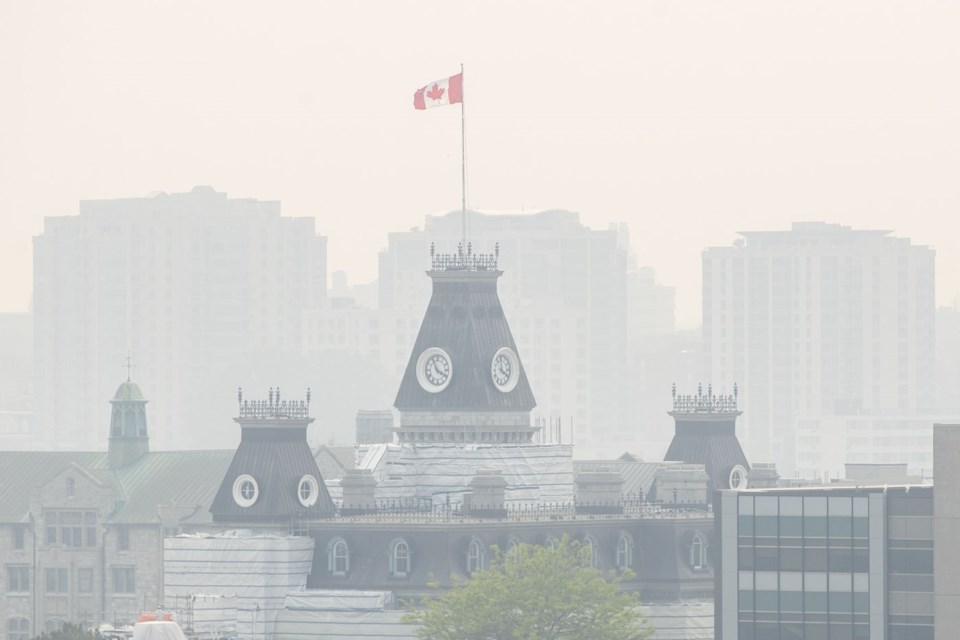TORONTO — New research that analyzes emergency department visits during Ontario's unprecedented 2023 wildfire season suggests public-health messaging such as air quality advisories and ensuring people have their medication can help asthma sufferers avoid trips to the hospital.
"There was a substantial increase in asthma-related ER visits in the first episode in early June, which was largely absent in the second episode that occurred near the end of that month," said Hong Chen, lead author of the study published Monday in the Canadian Medical Association Journal.
Although more research is needed to determine why there were fewer asthma visits during the later wave of wildfire smoke, the authors believe public awareness during the first wave, including air quality advisories, led people to take measures to protect themselves and their children.
Those protective measures could have included staying indoors, using air cleaners and having asthma medications ready, said Chen, who is a research scientist at health data organization ICES.
The researchers analyzed Ontario emergency department records from April 1 to July 31, 2023 — a period starting eight weeks before the first episode of heavy wildfire smoke in early June, to four weeks after the second episode in late June. That was the worst wildfire season the province had ever experienced.
They found asthma-related ER visits increased between 11 per cent to 24 per cent per day during and after the first wave of smoke. They did not find any increases during the second wave of smoke a few weeks later.
The researchers used ER visits for anything that wasn't respiratory or heart-related as a control outcome over the study time period.
Chen said the results show that people can take measures to protect themselves from wildfire smoke.
"The scale of the wildfires such as we observed in the year 2023 will likely happen in the future," he said.
People need to protect themselves and their children even in seasons when the wildfire smoke isn't as intense, Chen said.
"No level of exposure to wildfire smoke is completely safe. So that means that we really need to do everything we can to limit exposure," he said.
Sheila DeVries of Milverton, Ont., has two children with asthma and also has it herself. She remembers frightening trips to the hospital due to wildfire smoke during the summer of 2023.
"Our normal medication that we would take just wasn't doing it anymore," she said.
"My kids both have actually been on high flow oxygen and just seeing that and thinking, what's the next steps if this would continue to get worse? And yeah, you just hope and pray that it doesn't get worse."
Her nine-year-old daughter, Peyton Albrecht, was the worst-affected and had to stay inside for much of that summer, missing favourite activities such as swimming and camping.
Peyton controls her asthma with three inhalers, a pill every morning and a monthly injection from an allergist.
The family also has air purifiers throughout the house.
DeVries and both kids usually have the hardest time with their asthma during spring and fall because of allergies, she said, but wildfire smoke means summer can now be a risky time too.
The CMAJ study comes as wildfire season has already begun in British Columbia and dealing with poor air quality has unfortunately become a new normal, said Sarah Henderson, the scientific director of environmental health services at the BC Centre for Disease Control.
"What we consistently see is that wildfire smoke has a bigger effect on acute respiratory outcomes than other types of air pollution," said Henderson, who wrote a commentary accompanying the study in the CMAJ.
Wildfire smoke is different in several ways from other sources of pollution, such as traffic and industry, in a few different ways, she said.
"When it comes to the particles in wildfire smoke, they're far more complex than the particles from those other sources, because the fires are so dynamic. The temperature of the fire matters, the types of fuels that are burning matter. The meteorological conditions at the time of the fire matter," Henderson said.
Unlike industrial polluters, wildfires also can't be controlled at the source through regulations, she said.
But action from governments and other "top-down" measures are critical to controlling the effect of the smoke pollution by improving air quality, rather than just leaving it up to individuals to protect themselves with masks, air cleaners and asthma medication, Henderson said.
"Your ability to take individual measures is often going to be tied to your socioeconomic status. It's just not an equitable way to try to protect people from this exposure that we know is going to keep happening for the decades ahead," she said.
Canada needs to set an "indoor air quality standard," she said, mandating buildings to keep the concentrations of particulate matter that is small enough to get deep into people's lungs at concentrations below a certain level through air filtration.
Legislation to protect outdoor workers from poor air quality is also needed, she said.
WAYS TO PROTECT YOURSELF
Asthma Canada offers advice on how people with the condition can stay safe during wildfire season at https://asthma.ca/wildfires/. Their tips include:
-Keep track of local air quality updates.
-If the air quality is poor, stay inside as much as possible.
-If you need to go outside, wear a well-fitting N-95 mask and keep your reliever inhaler (usually blue) with you.
-Use high-efficiency (HEPA) air purifiers inside your home
-If you're using air conditioning, use the recirculation setting so you're not bringing outside air inside.
-Take your medications as prescribed.
-Stay hydrated.
-Develop an asthma action plan with your health-care provider as a guide on what to do if your symptoms get worse.
This report by The Canadian Press was first published May 5, 2025.
Canadian Press health coverage receives support through a partnership with the Canadian Medical Association. CP is solely responsible for this content.
Nicole Ireland, The Canadian Press



